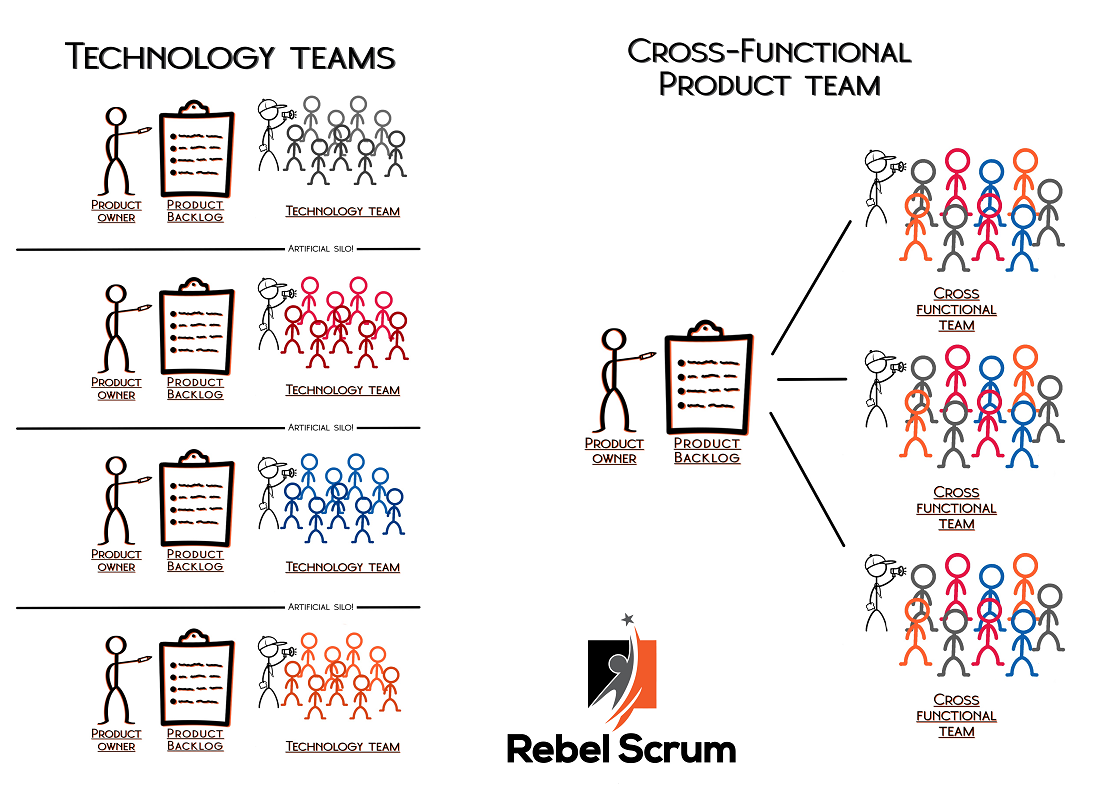According to the 2020 Scrum guide, “Scrum Teams are cross-functional, meaning the members have all the skills necessary to create value each Sprint.” But what does that mean, exactly?
Traditionally, when we think of software development teams, we envision developers or programmers working together to code and build software applications. While developers do play a critical role, Scrum teams transcend the boundaries of a typical development team. Scrum teams can comprise individuals with diverse skills, enabling them to tackle various aspects of the product development process. These skills may encompass a wide range of domains, including but not limited to business analysis, quality assurance, design, testing, technical writing, and any other competencies relevant to the specific product being developed.
The specific catalog of skills required within a Scrum team will depend on the nature and requirements of the product. For example, if the product aims to deliver human resources functions to an organization, the Scrum team may include individuals with expertise in human resources. This ensures that the team possesses the necessary knowledge and perspectives to address the unique challenges and complexities associated with the product's domain. To know what skills Developers need to deliver value each Sprint, the organization should conduct a product definition exercise.
Within a cross-functional Scrum team, each developer may specialize in a specific area of expertise. This specialization allows team members to focus on their strengths and contribute their specialized skills effectively. However, Scrum teams can also embrace a "T-shaped" approach, where each member possesses a broader skill set, encompassing a little of all the skills required. This promotes flexibility, adaptability, and collaboration within the team. A "T-shaped" team member can step in and provide support or assistance in multiple areas, fostering a culture of shared responsibility and collective ownership of the product's success.
The primary objective behind assembling a cross-functional Scrum team is to harness the power of thought diversity. By bringing together individuals with varied skills, perspectives, and knowledge, the team can tackle the multifaceted challenges encountered during the product development journey. Each team member contributes their unique expertise, ensuring a comprehensive understanding of different aspects of the product. This rich pool of knowledge allows the team to make well-informed decisions and produce high-quality deliverables.
The collaborative nature of a cross-functional Scrum team fosters a sense of collective responsibility and accountability. Rather than relying on a single individual to handle a particular task or domain, the team collectively takes ownership and collaborates to address any impediments or challenges that arise. This not only distributes the workload but also promotes a culture of shared learning and continuous improvement.
Debunking Common Myths About Cross-Functional Teams
Cross-functional teams have gained popularity and widespread adoption in modern workplaces. However, misconceptions and myths often hinder their successful implementation. Let's debunk some of the most common myths surrounding cross-functional teams and shed light on the realities of their benefits and challenges.
Myth 1: Cross-functional teams must have equal expertise in all areas
Reality: While cross-functional teams are meant to have a diverse skill set, it doesn't mean every member must be an expert in all areas. The focus is on having a mix of skills necessary to deliver the product incrementally. While teams may choose to have t-shaped people, some teams may choose to have business analysis experts or testing experts on the team.
Myth 2: Cross-functional teams eliminate the need for specialists
Reality: Cross-functional teams aim to reduce dependencies on external specialists but may still require their expertise. Specialized knowledge or skills may be needed for certain tasks, and collaboration with specialists outside the team is encouraged when needed. There is a balance though; if the team requires outside expertise every Sprint, then the team may consider ways to grow their team to bring in these skillsets so that external dependencies are reduced to a manageable level.
Myth 3: Cross-functional teams work on multiple projects simultaneously
Reality: Cross-functional teams are designed to focus on a single project or product at a time. Splitting team members' attention across multiple efforts can lead to reduced efficiency and effectiveness.
Myth 4: Cross-functional teams eliminate the need for coordination and communication
Reality: Effective coordination and communication are still crucial in cross-functional teams. While having a mix of skills within the team helps, it's important to ensure that all team members are aligned, understand their roles, and work towards a common goal.
Conclusion
The term "cross-functional" in the context of Scrum signifies the composition of a team with diverse skills and expertise necessary to deliver a valuable product increment. By embracing cross-functionality, Scrum teams can leverage the strengths of individual team members, foster collaboration, and collectively tackle the complexities of the product development process. Through this approach, Scrum teams can optimize their potential for success, enabling them to adapt, innovate, and deliver products that meet the evolving needs of their customers and stakeholders.
Are you interested in hearing from thought leaders in Scrum and networking with industry leaders? Join us for this year’s Scrum Day conference in Madison, Wisconsin.


